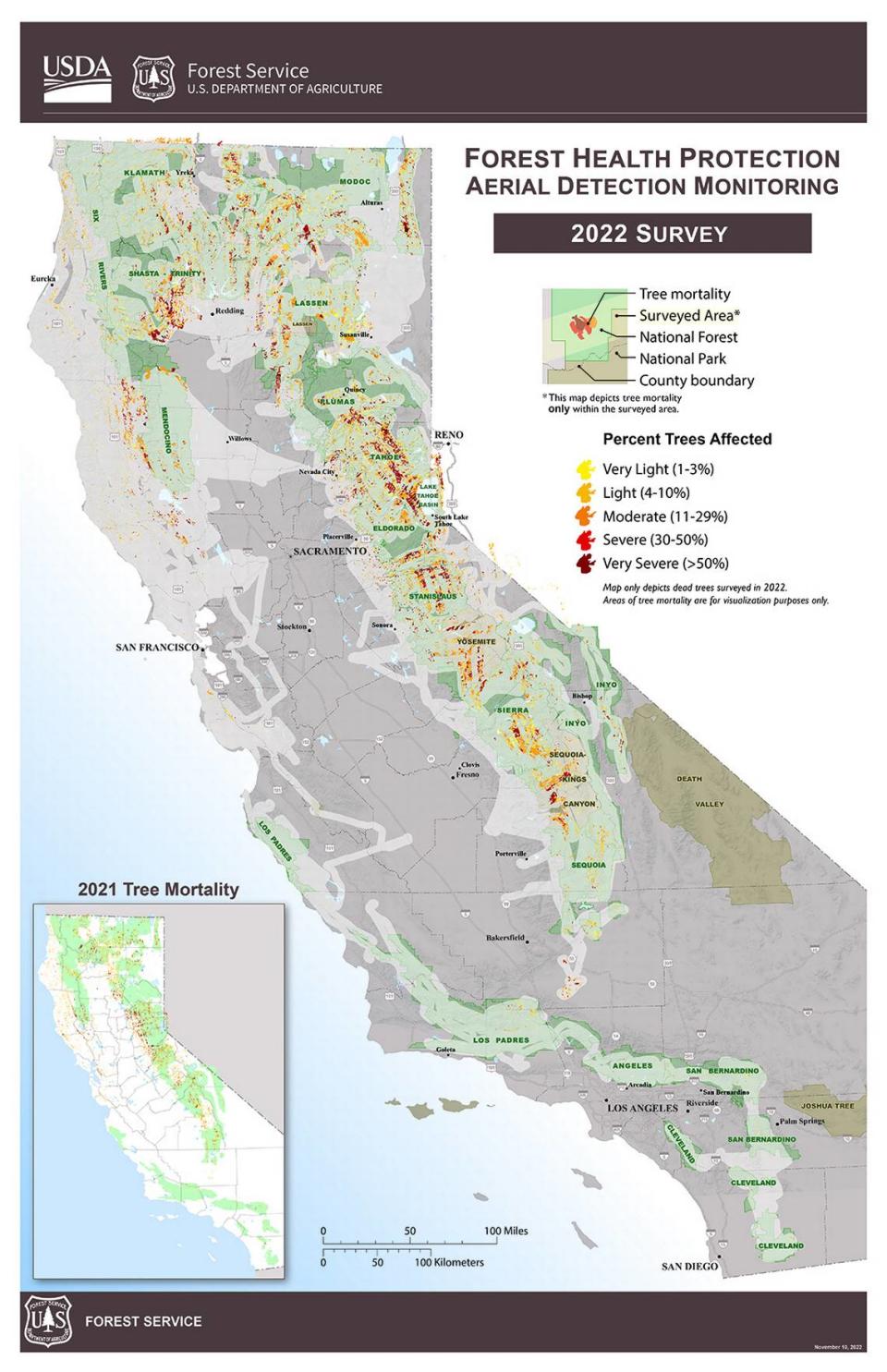36 million trees died in California, 2022 report says. Where was the biggest increase?
More than 36 million trees died last year in California’s forests, the U.S. Forest Service said in a recent annual report — far more than in 2021, as continuing severe drought conditions exacerbated long-standing environmental challenges and potential wildfire danger in the state.
The aerial survey, conducted between July and October, uncovered an estimated 36.3 million dead trees across 39.6 million acres surveyed.
The 2022 total nearly quadrupled the 9.5 million dead trees detected in 2021, and mortality was detected across double the area, found throughout 2.55 million acres of forest last year compared to 1.26 million acres in 2021.
The mortality total is California’s highest since 2016, when an estimated 62 million dead trees were detected in the survey. That figure came at the tail end of the state’s last major drought, which dominated the 2010s. The survey was not conducted in 2020 due to the COVID-19 pandemic.
Tree mortality is a direct product of disease and damage from insects, such as bark beetles. Trees are far more susceptible to insect damage when weakened by drought and climate change, according to the Forest Service.
An increase in tree mortality elevates California’s wildfire risk by producing dry fuels. It also destroys critical wildlife habitats.
Tree death in 2022 was most heavily concentrated “where drought conditions were most exceptional,” Forest Service officials wrote, and the “average severity of mortality was also significantly higher.”

Tree death increasing in Sierra Nevada mountains
The dead fir tally in 2022 marked the highest ever recorded by the Forest Service’s aerial survey, according to the report. Fir trees comprised more than 77% of the 36.3 million dead trees, including some 15.2 million red firs and 12.8 million white firs.
Mortality of true fir trees “was particularly severe and widespread in the central Sierra Nevada range.”
An estimated 1.4 million trees died in El Dorado County in 2022, a nearly tenfold increase from 156,000 in 2021. Placer County jumped to 3 million, from 452,000 in 2021; and Alpine County to 1.2 million from 332,000.
State researchers expressed concern last year about mortality in the Sierra Nevada mountains.
The Sierra Nevada Conservancy, a state agency, wrote in November that preliminary data from the 2022 aerial survey “suggest the emergence of a new tree mortality event disproportionately impacting higher-elevation fir forests in the northern and central parts of the state.”
“Drought conditions, high temperatures and dense forests drive tree mortality throughout the Sierra Nevada,” the conservancy wrote.
“Following California’s third consecutive dry year, and record-low precipitation during the 2021 snowy season, tree mortality is showing up in places that were largely spared during the 2012-2016 tree mortality event centered in southern Sierra pine forests.”
Researchers said the last decade’s tree mortality event was largely to blame for the severity of the Creek Fire, which burned close to 380,000 acres (594 square miles) in Fresno and Madera counties in 2020, mostly in densely forested portions of Sierra National Forest.
The Sierra Nevada Conservancy in its report said the growing threat of tree mortality highlights the need for forest-thinning projects. “The lack of water supply is exacerbated by increased competition among trees located in dense forests,” researchers wrote.
Torrential storms from late December through mid-January offered a major boost to California’s snowpack levels.
A spate of atmospheric rivers eased drought conditions in the short term, but it will take a longer period of sustained wet weather before the state’s ongoing drought can be considered over.
“What happens next will depend on future weather patterns, and whether land managers can catch up on long-needed, forest-restoration efforts,” the Sierra Nevada Conservancy wrote in November.

 Yahoo Movies
Yahoo Movies 